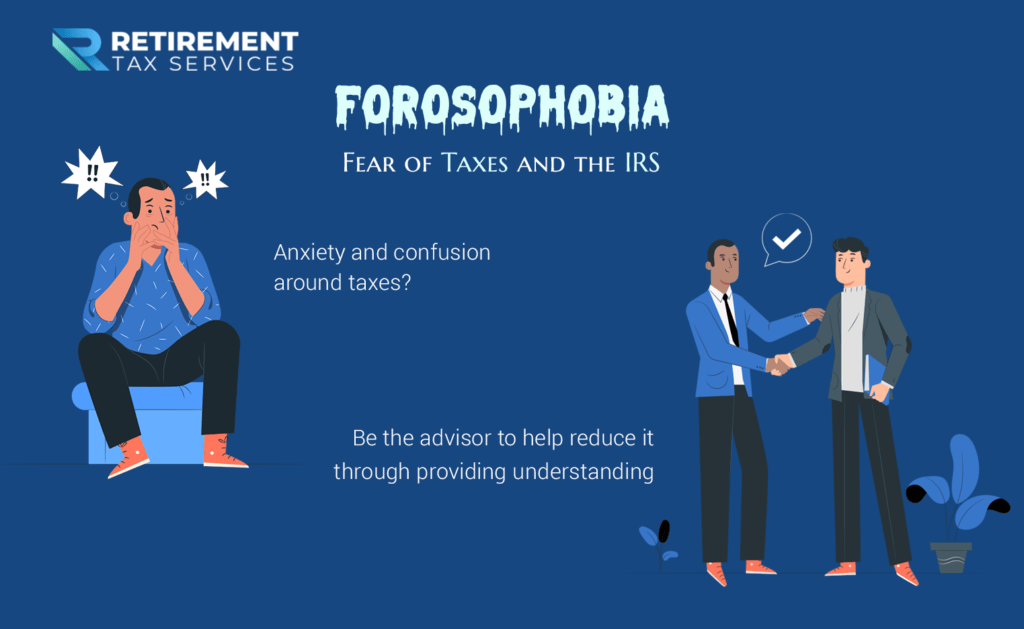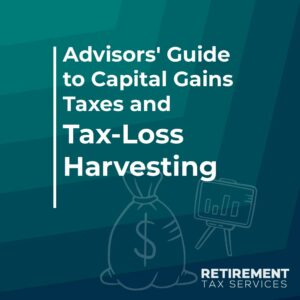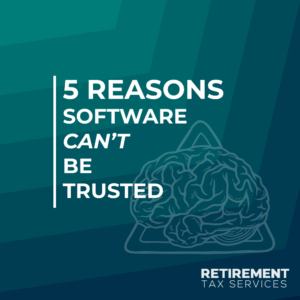Background:Forosophobia
In February of 2021, a psychologist suggested a new phobia in Psychology Today: Forosophobia is the proposed “fear of taxes and the IRS.”
The majority of your clients may not have strong enough negative feelings about taxes to warrant calling them phobias. However, they are also unlikely to have positive feelings about taxes or the IRS, either.
For most of us, rather than crippling tax fear, it’s tax confusion and anxiety. The good news is that these symptoms are generally treatable. In fact, usually there’s no need for seeking medical attention.
Joking aside, there is a lot of tax confusion and anxiety for many of your clients. Meanwhile, there is plenty that you, as a financial advisor, can do to help.
The starting point is becoming the person in their lives who starts pulling back the curtain: Help them understand the areas of taxes that most directly impact them.
The tax code is a mystery to most people. In fact, it’s not just that people don’t know the rules. The whole thing can feel unknowable to some. This is the trade-off with huge amounts of widely available information: As a result, someone has to sort through it all and figure out what is relevant to a specific situation.
The rational responses for the uninformed may be tax confusion and anxiety. However, our clients aren’t doing this on their own. That’s why they come to you.

Complexity Does Not Equal Value
Other articles on our website have discussed specific planning strategies you can use with your clients. However, there is tremendous value in what may seem like simple things to you. For example, walk them through their tax return, line by line.
Rookie advisors might go down the Form 1040, explaining that “Line 1 is wages,” “Line 2 is interest,” “Line 3 is dividends,” and so on.
That’s not value.
Value, to your client, is walking them through their return. Help them understand the areas that are meaningful to their situation. In other words, help eliminate tax confusion and anxiety.
This is not the tax code “for dummies,” either: Don’t talk down to your clients or use needlessly technical jargon. Tax confusion and anxiety are symptoms; not IQ metrics.
They have to pay taxes every year. As a committed financial professional in their lives, help them understand what it is they are paying.
Value, to your clients, is reducing their anxiety and confusion. Shift through all the noise around taxes and get to what directly impacts them.
Page 1 of the 1040 (2020 edition)
To illustrate how advisors can approach this better, the following are potential scripts advisors can use with clients. Accordingly, they are based on a fictitious client couple.
As a result, you will need to tailor them to your own clients. Regardless, they should give you a reference for making these conversations relatable.
Intro
Bob and Sue, we get a lot of questions from clients on just what it is they are looking at when they see their tax return every year. So, I want to take a few minutes and highlight a few things on the 1040 that are important for your situation.
Wages, Salaries, Tips, Etc.
Line 1 is the money you earned this year from your jobs at ABC Company. The amount that gets reported to the IRS is not your full salary. Pre-tax amounts like your retirement plan contributions and your portion of health insurance premiums are subtracted before being put on the tax return.”

Tax-Exempt Interest and Taxable Interest
“Line 2 is interest you received during the year. It’s split into 2 buckets, but you just had taxable interest from your savings account at Home Town Bank. That’s a small amount, but it’s what we would expect, based on the investment allocation we are currently using.”

Qualified Dividends and Ordinary Dividends
“Line 3 is dividends and based on your current investment portfolio, we would not expect to see a balance here.”

IRA Distributions
“Line 4 is where distributions from IRAs are reported. You are both still working, so there is no activity here for 2020. But, this is where you will see distributions from your Fidelity account reported when you start drawing from it during retirement.”

Tax Confusion And Anxiety vs. Friendly Explanation
Pensions and Annuities
Line 5 is labeled ‘Pensions and Annuities,’ now Bob and Sue. For your situation, this is where activity from your 401k plans at ABC Company will be reported when we get to that point.”

Social Security Benefits
“Line 6 is Social Security benefits, which again is not applicable for you yet. But, this is where we will see it come through when you start drawing Social Security in retirement.”

“Capital gain or (loss)
““Line 7 is where capital gains are reported. We love capital gains because they are taxed at preferential rates. When we plan ahead, we can do things to strategically take advantage of those rates. In fact, capital gains come from selling assets that have appreciated in value, like securities or property. When you are ready to sell your rental house, this is where the gain on the sale will be reported.”

Other Income
“Line 8 is a bit of a catch-all for a lot of other income sources. Right now the amount on this line is showing the net income from your rental property. That is shown in more detail on Schedule E.”

Total Income
Line 9 is your total income. Congratulations to both of you! That shows a lot of hard work and dedication on your part.”

Adjustments to Income
“Line 10 is a variety of adjustments to income. You did not have any this year, but as part of our review of your return, we went through to make sure there weren’t any that should be included. Nothing stood out.”

Bob & Sue’s Forosophobia Bright Future
Adjusted Gross Income
“Line 11 takes us down to your adjusted gross income, or AGI. This is a number that gets talked about a lot. That’s because the IRS uses it to determine your eligibility for different credits and deductions. For 2020, you were not close to any thresholds that would change your tax situation. However, this is something we look at every year as we make recommendations to you.”

A lot of assumptions in these scripts are specific to “Bob and Sue.” However, my goal isn’t to give you the details. In other words, incorporate changes based on the particular clients you are talking to.
The point of this exercise is to give you the tone and vocabulary that great financial advisors use (and get great feedback on). Check back for round 2 of this topic. Watch for our coverage of the 2nd page of Form 1040, as well.
Take Action Against Tax Confusion And Anxiety
- Practice. If this is new (or even just a new approach) for you, make sure you practice. Do it before you sit down in front of a client. Start with your own return. Next, go line-by-line, putting things in terms that are helpful for a client. Avoid overly technical terms. Prevent tax confusion and anxiety.
- Learn From Others. Leverage your network of advisors. Find another advisor committed to delivering value through taxes. Next, offer to take turns going through a tax return. Use real, redacted client returns (for which Adobe has a great tool). This is a great opportunity for you to practice. Learn from someone else to see what works, too.
Remember to tip your server, not the IRS.





